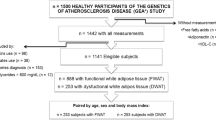Abstract
OBJECTIVE: The aim of this study was to examine the relation between the CETP-TaqIB polymorphism and reduced plasma HDL-cholesterol levels commonly observed among men characterized by abdominal obesity and features of the insulin resistance syndrome.
SUBJECTS: A total of 187 sedentary men, non-smokers and free from metabolic disorders were classified on the basis of their CETP-TaqIB genotype.
RESULTS: Plasma HDL and HDL3-cholesterol concentrations as well as the CETP activity were significantly different between the three genotypes, B1B1 men having significantly lower HDL and HDL3-cholesterol levels and higher CETP activity than B2B2 homozygotes. A 2×3 ANOVA was used to determine the source of variation of plasma HDL and HDL2-cholesterol levels among the three genotypic groups of men divided on the basis of either a high (≥27 kg/m2) or a low (<27 kg/m2) BMI, a high (≥130 cm2) or a low (<130 cm2) accumulation of visceral adipose tissue assessed by computed tomography, or a low versus a high fasting plasma insulin concentration (using the median value as a cut-off point). The effect of the CETP genotype observed on plasma HDL-cholesterol concentrations was attenuated among men with features of the insulin resistance syndrome. It seems that the expected raising effect of the B2 allele on plasma HDL-cholesterol concentrations was blunted in the presence of a BMI≥27 kg/m2, a high accumulation of visceral adipose tissue or hyperinsulinaemia.
CONCLUSION: Our data indicate that the CETP gene TaqIB polymorphism influences plasma CETP activity on one hand and plasma HDL-cholesterol concentrations on the other hand among men. The association between the TaqIB polymorphism and plasma HDL-cholesterol concentrations is altered by the presence of abdominal obesity and some features of the insulin resistance syndrome.
This is a preview of subscription content, access via your institution
Access options
Subscribe to this journal
Receive 12 print issues and online access
$259.00 per year
only $21.58 per issue
Buy this article
- Purchase on Springer Link
- Instant access to full article PDF
Prices may be subject to local taxes which are calculated during checkout
Similar content being viewed by others
Author information
Authors and Affiliations
Corresponding author
Rights and permissions
About this article
Cite this article
Vohl, MC., Lamarche, B., Pascot, A. et al. Contribution of the cholesteryl ester transfer protein gene TaqIB polymorphism to the reduced plasma HDL-cholesterol levels found in abdominal obese men with the features of the insulin resistance syndrome. Int J Obes 23, 918–925 (1999). https://doi.org/10.1038/sj.ijo.0800972
Received:
Revised:
Accepted:
Published:
Issue Date:
DOI: https://doi.org/10.1038/sj.ijo.0800972
Keywords
This article is cited by
-
Studies of the CETP TaqIB and ApoE Polymorphisms in Southern Thai Subjects with the Metabolic Syndrome
Biochemical Genetics (2015)
-
CETP Gene Polymorphism in the Caucasian Population of West Siberia and in Groups Contrast by Total Serum Cholesterol Levels
Bulletin of Experimental Biology and Medicine (2014)
-
Genetic epistasis in the VLDL catabolic pathway is associated with deleterious variations on triglyceridemia in obese subjects
International Journal of Obesity (2007)
-
The metabolic syndrome: A crossroad for genotype-phenotype associations in atherosclerosis
Current Atherosclerosis Reports (2004)



